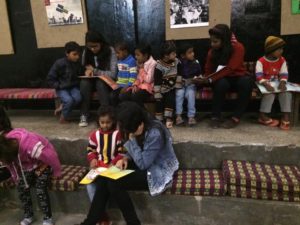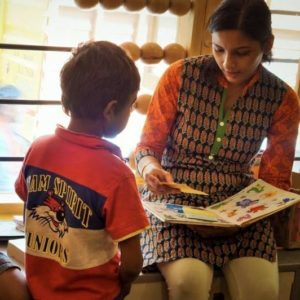 Prof. Alok Rai, Ex Faculty, Department of English, University of Delhi.
Prof. Alok Rai, Ex Faculty, Department of English, University of Delhi.
Born and bred in Allahabad, Prof. Alok Rai grew up in an affluent Hindi – Urdu environment which explains his strong linguistic background. He holds a graduate degree in modern English literature and became a Rhodes Scholar at Oxford. At, the University College of London, he had written a Ph.D. dissertation on George Orwell and later he has also published books on the said author while also writing on the formation of modern Hindi. As a translator his translation of Nirmala was published by Oxford University Press many years ago. He has been involved with the business of writing, with language in society. His interests include, Modern English Literature; cultural processes in modern North India, with particular reference to issues of language and literature.
He is also the grandson of the legendary Hindi writer Premchand. Years ago when I was guest-editing the special issue of Children’s and Young Adult literature of The Book Review I asked him for a review of series of biographies that had been published in Hindi by Children’s Book Trust. ( Chirsmaraniya Mahaan Vyaktitva Vol 1-9, Illustrator: Sahana Pal Children’s Book Trust, 2001) I no longer have the bibliographical details with me but I discovered that the review had been posted online. ( http://www.orchidapps.com/goodbooks/node/5968#.Uhs0T5Jgdsl ) . I am reproducing the review as is.
We hate poetry, Keats wrote, that has a design on us. This set of short “inspirational” biographies, published by the Children’s Book Trust – with an average of 5 or 6 worthies per each one of nine volumes – goes well beyond design. This is, as the criminal lawyers say, “intent”- as in “loitering – and the intent is deadly serious. Because of course the underlying purpose of the series, indeed of such series, is nothing less than the abduction of the young, seizing their minds well before they have reached the age of consent. Even more crucially, of dissent.
There is a tendency in our gerontocratic civilization to treat matters pertaining to children as being not very important. There is no reason, here, to run through the familiar complaints about the priorities that enable aging gentlemen to acquire toy phalluses at enormous state expense even as they can’t find the funds to provide schools, or meals, or medicines for millions of children. And yes, of course, I know that there is a distinction to be made between the said aging gentlemen and the good men and women who have collaborated in this CBT project of providing these inspirational biographies – and of course I’m joking when I accuse them of “criminal” intent. But there is a serious argument here: what we do to our children, whether with the connivance of the NCERT or without it, is crucially important. And while this CBT series might seem a somewhat modest vehicle to bear the burden of a serious argument, at least there is no danger here of offending Their Lordships, and so understating the seriousness of the issues on which They have pronounced breezy obiter dicta.
But let us get over the grosser matters first. No one can assemble a list that is universally acceptable, and while one may quibble about why X or Y is or isn’t one of the persons chosen for such hagiographic, inspirational treatment, the actual CBT list is, for better and worse, catholic and random. There are sundry 19th century figures – Gokhale, Dadabhai Naoroji, Sir Syed – and lots of the other kind. Muslims? – aforementioned, and Khan Abdul Ghaffar Khan, Kidwai, Azad –and I wouldn’t expect Jinnah here anyway! (No Nehru or Gandhi, either, by the way.) Women? – Vijayalakshmi Pandit (!), Annie Besant, Kamla Nehru, Ba. Writers – Bankim, Bharati, Iqbal – and scientists – Meghnad Saha, Bhabha, Visweshwarayya. Lots of politicians, of course: whatever would we do without them? More importantly, whatever shall we do with them? I might have said that the inclusion of Savarkar and Shyamaprasad Mukherji in this august company is surprising – but it isn’t, is it?
It is also not my case that there is no room for inspirational stories in the necessary socialization of the young. Indeed, I would argue that it is the neglect of this essential dimension of education in our schools that is both a cause and a symptom of the coarsening of our society, the rampant desensitization that emboldens a Modi or a Singhal or a Togadia to gloat over the grief of the victims of Gujarat in the hope of reaping an electoral advantage. Persons – and so, a collective, a civilization of persons – is distinguished by the texture of their moral anxieties, by their unique sense of moral occasion, and by the narratives in which the implications of their defining moralities are laid bare. Nothing very complicated, this is Arjuna at Kurukshetra, being lectured to by his charioteer – endlessly kitschified, this still fulfils an essential sustaining function. Just as the moral conflicts that are regurgitated by Bombay melodrama do. We are the kind of people who notice, so to speak, moral conflicts. And that indeed is exactly where my problem with this inspirational gallery assembled by the CBT lies. Quick clarification: whether or not our society is rapidly descending into anomie, into a moral vacuum, is not at issue. The question is, how is this situation to be addressed? Are the self-proclaimed and much-touted doctors really equipped with a cure – essentialized religion, 100% proof ! – or are they themselves only symptoms of the malady, and more likely than not, will only exacerbate the situation by their crude ministrations? My answers to these question are, respectively and respectfully, no, yes, and yes.
Elizabeth Taylor, the well-known philosopher, once said, “The problem with people who have no vices is that generally you can be pretty sure they’re going to have some pretty annoying virtues.” Well, there aren’t many vices on offer here – but there is a serious danger of OD-ing on virtue! OK, cut to the chase – obviously, every “life” is a selection – children discover very early on that you can’t even tell a single day in its entirety. So, my problem is not with the fact that the biographies here assembled are selective – but rather with the understanding that motivates the selection. The way I understand it, inspirational narrative works through the common narrative experience of identification: above a certain minimal level of complexity, the reader/listener is enabled to identify with a number of characters or, modishly, subject positions, with good and bad, with high and low, so that one can experience moral difficulty, because it is only out of moral difficulty that one develops a sense of moral complexity. Children’s fables about always being good and always telling the truth and always always respecting your elders are treated by children with the contempt they deserve. The trouble with these monsters of goodness is that no one can identify with them – one may be forced to admire them, or one admires them, but one cannot identify with them: they inhabit a mythic realm far above the muddled worlds in which we must live. So, what’s wrong with that? They are models of goodness, towards which we aspire, right?
Wrong! In fact, such “heroic” biography has been the staple of fascist pedagogy: larger than life characters who never never do anything wrong, except to draw some significant moral lesson from it, so that their narrated lives are a relentless accumulation of virtue – virtual money in a virtuous bank, so to speak. However, this dread moral lesson works rather paradoxically, because its highly coloured universe succeeds only in communicating not the possibility of virtue for us mere mortals, but its impossibility. The humanist alternative to such fascist “heroic” biography is biography that enables us to identify with the common humanity – common to reader and narratee, to mahaan vyaktitva and child reader – by showing the great man also as being vulnerable to human frailties etc. The possibility of virtue. We are enabled, ideally, to redeem the ordinary life we live by aspiring to live it differently. “Heroic” biography – the mode that I have designated as fascist, both by association and tendency – on the other hand, encourages one to turn to such biographies as necessary and necessarily mythical for a life that is rendered unredeemed and unredeemable. That is the sense in which such simple-minded, direct reaching after unalloyed virtue, through the instrumentality of selective biographies is not just naïve and pointless, it is positively harmful: even worse than the TV that our poor children would rather watch. And who can blame them?
26 Aug 2013
(C) Prof. Alok Rai

Prof. Alok Rai will battle it out along with three other renowned experts at the forthcoming JumpStart festival
( http://www.jumpstartfest.com/home ) during the session entitled ” The Great Language Debate”. It promises to be provocative – even revolutionary – ideas about the future of our languages and cultures. Are we building a healthy and sustainable ‘bibliodiversity’ for the next generation? Or are we creating a whole generation of linguistic exiles, neither ‘at home’ in their mother tongue nor in English? Can we move towards a common language without ‘flattening’ culture?





